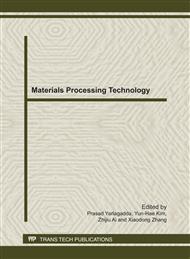p.125
p.133
p.138
p.142
p.146
p.151
p.155
p.159
p.163
Experiments on Preparation of Cutting Tool Edge Using Abrasive Water Jet
Abstract:
Preparation of cutting tool edge using micro abrasive water jet is proposed in this paper. A specific designed water jet machine tool with four axes was developed. Also a specially designed abrasive nozzle assembly for preparation of cutting tool edge has designed. The inside diameter of orifice is Ø125μm. The abrasive nozzle has three sections, i.e. the contraction section, the cylinder section and the diffusion section. The diffusion section has a quasi rectangular profile. Experiments on preparation of coated inserts of cutting tool using micro abrasive water jet have been carried out. The silicon carbide solid abrasive with 400 meshes was used during the experiment.The results show that the sharp edge was rounded by micro abrasive water jet. A honed edge with very small radius exists and irregular zigzag edge was disappeared after preparation. Experiments also show that the linear waviness on the surface was eliminated completely by preparation process. The surface roughness of the coated inserts increased to Ra 0.526μm from Ra 0.025μm after preparation. It demonstrates that the tool edge strength could be enhanced and the micro defects could be eliminated during this course. It proved that preparation of cutting tool edge by micro abrasive water jet is feasible and practical. Because of effective, efficient, environmental friendly and higher quality compared with other preparation method, it has promising application in the field of cutting tool manufacturing.
Info:
Periodical:
Pages:
146-150
Citation:
Online since:
September 2011
Authors:
Price:
Сopyright:
© 2011 Trans Tech Publications Ltd. All Rights Reserved
Share:
Citation:


